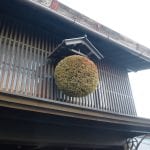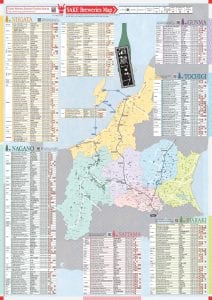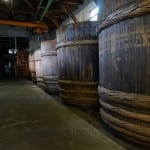 Tourism in Japan is healthy – and on the rise. It has been for years, and will likely continue right up to and through the Tokyo Olympics in 2020.
Tourism in Japan is healthy – and on the rise. It has been for years, and will likely continue right up to and through the Tokyo Olympics in 2020.
For the most part, this is a good thing. But not everyone in Tokyo – or Japan – will wholeheartedly agree. And, I can in fact understand and sympathize with those that see more hassle than opportunity. Not everyone wants to deal with the entire world at the doorstep, and that is their prerogative.
At the same time, interest in sake is exploding. It’s kind of nuts, actually, and is decidedly a good thing. And about time, too.
So, naturally, many visitors to Japan will want to check out sake breweries when they are here. Shochu distilleries as well will be interesting to many, but the majority of those are in southern Japan, not in the Tokyo area.
And in concert with this, the government in Japan is promoting “Sakagura Tourism” to both domestic and international audiences. This, too is a cool thing, as it develops interest in sake (and shochu, of course) that will lead to more growth. Amongst their many efforts in this area is the creation of sakagura tourism maps, which I introduced in Issue #199 of this newsletter, two months ago. These do not yet exist for all regions in Japan, and those that have been released are not all at the same level of comprehensiveness. But at least one region, the Kanto Shinetsu region, which includes the areas around Tokyo, also has a column for each sakagura that lists whether or not they allow visitors.
But in truth, this has presented problems for many sakagura. With but one very small column on the map to say “possible” or “not possible,” they had no room to  qualify the response. And so “visits possible” gets taken as “hey, man, just drop in any time with as many of your friends as you like! We’ll happily drop everything and attend to you!” Conversely, “visits not possible” ends up sounding like “we are dour and arrogant bastards who do not appreciate our customers; stay away!”
qualify the response. And so “visits possible” gets taken as “hey, man, just drop in any time with as many of your friends as you like! We’ll happily drop everything and attend to you!” Conversely, “visits not possible” ends up sounding like “we are dour and arrogant bastards who do not appreciate our customers; stay away!”
Of course, neither of those extremes is at all the truth. But amongst those sakagura that said visits are possible, there are those that are already finding themselves overwhelmed, or at least see the potential of that happening in the future. So some are taking reasonable measures to make sure they can focus on what is most important.
So, in fairly stark contrast to much of the modern wine world, the sake industry and most of the sakagura themselves that comprise it were not – and are not – set up for tourism. That does not mean that they do not allow or do not want visitors. Most of them are, in fact, open to that. They fully understand the marketing benefits of having people feel close to the source and understanding more about sake. That is all fine.
Let’s look at the realities here. Consider most sake breweries in Japan: of the 1200 remaining, about 1000 are very small operations, family owned and run. Such places were never set up for visitors, especially not touristic visitors. In fact, there were never considered appealing tourism-wise.
They might have a staff of ten, five of which brew, two of which run the front office, and a couple more that sell or drive trucks. Perhaps these numbers are doubled; regardless, almost none have dedicated tour guide staff. So when people come knocking for tours, most of the staff are busy actually making the sake itself. It is not realistic to expect them to be able to stop something like the super timing sensitive craft of sake brewing to give tours on anything remotely resembling a regular basis.
Furthermore the inside of sakagura are not exactly set up for us normal folks. Kura are cramped, dark, wet, cold, slippery, often with makeshift scaffolding and ladders here and there, with absurdly steep stairs and other less than fully safe environments.
 And that is just the consumer side of the issue. The sake itself is a delicate balance of micro-organisms that are very much affected by other micro-organisms. Sanitation is paramount. That’s why they have you change shoes sixty-five times, wash your hands often and often even squirt alcohol on your hands. Yes, they want to share their craft and creation with you. But they need to maintain standards to be sure it stays consistent and good. And the more people that go traipsing through the kura, the harder that is.
And that is just the consumer side of the issue. The sake itself is a delicate balance of micro-organisms that are very much affected by other micro-organisms. Sanitation is paramount. That’s why they have you change shoes sixty-five times, wash your hands often and often even squirt alcohol on your hands. Yes, they want to share their craft and creation with you. But they need to maintain standards to be sure it stays consistent and good. And the more people that go traipsing through the kura, the harder that is.
As alluded to above, one brewery in the Kanto area, about two or three hours north of Tokyo, put a notice on their web page that set limitations on visitations. In short, they very politely stated that, as much as they would love to remain as accessible and open as possible, that brewery visits would be limited to groups that do so with either a distributor or another sake industry person or company. They referenced as reasons much of what is outlined above, and expressed reticence at needing to do it this way. But in the end, they are just protecting their company and the quality of their brew.
While it was only one brewery in the Kanto area that posted this, other are expected to follow that example. I think it will continue along those lines, and in the end, I think it would be great if the government body promoting sakagura tourism, or some other such body, steps in and addresses this in a way that is helpful to everyone.
Let us see what unfolds.
Bear in mind there are, in fact, many breweries that are set up for tourism; some have gift shops and even restaurants. And many others are open to it as well. But being busy with skeleton crews, and not necessarily having language support may hamper their best efforts. So by all means, try to visit a brewery when you come to Japan. But be understanding, considerate and reasonable as well.




